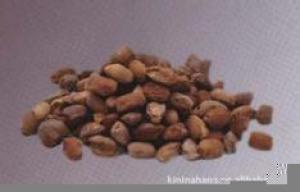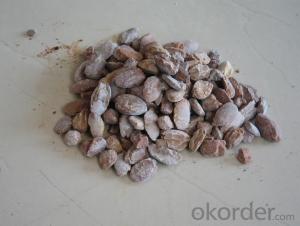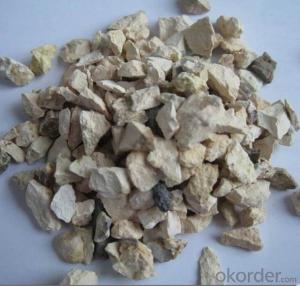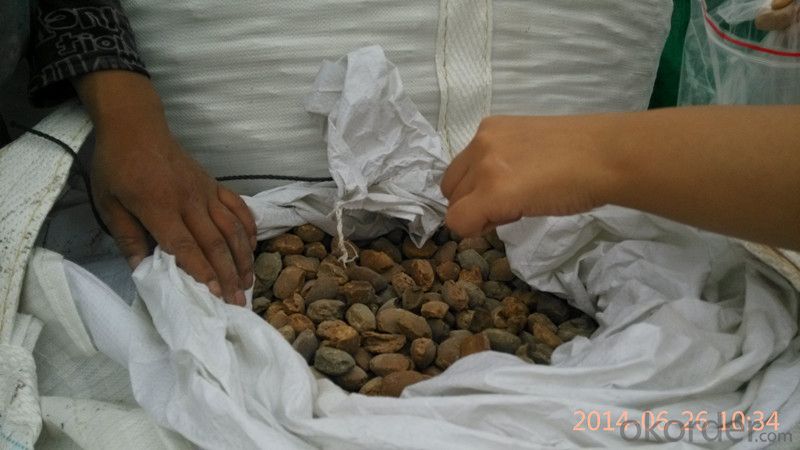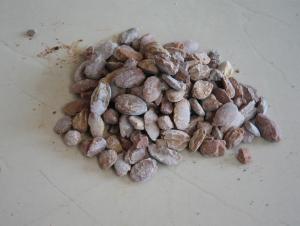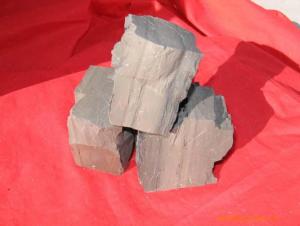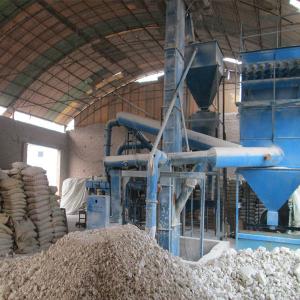Raw Materials for Refractory:Dead Burnt Magnesite MgO 91%
- Loading Port:
- China Main Port
- Payment Terms:
- TT OR LC
- Min Order Qty:
- -
- Supply Capability:
- 2000 m.t./month
OKorder Service Pledge
OKorder Financial Service
You Might Also Like
| Item | MgO | SiO2 | CaO | LOI | B.D.(g/cm3) |
| DBM-97 | 97 | 0.7 | 1.4 | 0.2 | 3.2 |
| DBM-96 | 96 | 1.5 | 1.5 | 0.2 | 3.2 |
| DBM-95 | 95 | 2.2 | 1.6 | 0.3 | 3.2 |
| DBM-94 | 94 | 3 | 1.6 | 0.3 | 3.2 |
| DBM-93 | 93 | 3.5 | 1.6 | 0.3 | 3.2 |
| DBM-92 | 92 | 4 | 1.6 | 0.3 | 3.18 |
| DBM-92 | 92 | 4 | 1.6 | 0.3 | 3.18 |
| DBM-91 | 91 | 4.5 | 1.6 | 0.3 | 3.18 |
| DBM-90 | 90 | 4.8 | 2 | 0.3 | 3.18 |
| DBM-87 | 87 | 7 | 2.2 | 0.3 | 3.2 |
Dead burned magnesite- DBM-is produced using selected natural magnesite that is purified and is calcined in a shaft kiln.The final product is used for electric furnacefloors and furnace liner tamping.
Main products level :
0-1mm;1-3mm;3-5mm;0-10mm;0-30mm
50 to 325mesh (90% through)
Product feature:
high temperature performance and high-density, strong anti-permeability ability and easy to rapid sintering, very thin sintered layer,good thermal shock stability, strong slag-resistance, long service life and so on.
Product function:
Apply to the construction of bottom and wall of all kinds steel making electric arc furnace and ferroalloy smelting furnace for hot charging of hot metal and second hand steel
Product usage:
Mainly used in producing common magnesite brick, magnesite aluminum brick, magnesite chrome brick, gunning mix, hot patching mix for converter and EAF ect .
Product Advantage:
Our factory produce the products of the Dead-burned magnesite are selected natural magnesite, it is produced by mine-selecting, purifying, calcimine in shaft kiln. It is an ideal material for unshaped refractory material, the final products are used in open hearth furnace, electric furnace bottom and furnace's lining tamping.
- Q: What are the refractory materials above 1000℃
- It is a piece of cake to meet your requirement, anyway you can try unshaped castables like corundum and other refractory materials used in steelmaking which are above 1500℃ basically .
- Q: Can anyone say something about the curtain wall fire-proof material key sealing point?
- Hello. 1. Gaps between the curtain walls and floors of all tier and partitions outer edge should be sealed with non-combustible material or flame retardant materials. Filling material can be rock wool or mineral wool, whose thickness should be not less than 100mm and should meet the designed fire endurance requirements, forming fire and smoke prevention areas between floors and rooms. Fireproof layer should use galvanized steel bearing with thickness of not less than 1. 5mm, and should not use aluminum plate. Gaps between bearing plate and main structure, curtain wall structure and the bearing plate should be sealed by fireproof sealant; fireproof sealant should has fireproof inspection reports granted by statutory testing organizations. 2. When building designs requiring transparent effect of fire compartment and separation, monolithic fire-resistant glass or hollow and laminated fire-resistant glass nade by monolithic fire-resistant glass can be adopted. 3. Windowsills-free curtain walls, incombustible entities skirt wall or fireproof glass wall whose fire endurance is not less tan 1.0 hour and height is not less than 0.8m should be set on the outer edge of each floor. The thickness of reinforced concrete floor or height of the side beams should be counted when calculating the height of the skirt wall. 4. Fire protection layer should not contact directly with the glass curtain wall, and the side towards the glass of fireproof materials should be covered with the decorative material. 5. Glass units of the same curtain wall should not cross two fire?compartments.
- Q: Why does refractory need to add coarse firstly and then add fine aggregate?
- Binding agent can wrap particles and improve binding effect.
- Q: What are the fire resistance ratings of the glass partition?
- The glass partition system is composed entirely of metal structures, glass, color plate and other materials which also has fire resistance capacity. When the inner structure of the system is steel structure, the fire resistance of which is 30 mins, 60mins or even longer. The fireproof glass is a special glass which is able to maintain its integrity and insulation in a fire resistance test. According to fire resistance performance, it can be divided into three categories: Class A: The fireproof glass which meets demands of fire integrity and fire insulation at the same time. This glass has advantages of excellent transmittance, fire-proofing(smoke resistance, fire insulation, and blocking heat radiation), sound insulation and impact resistance. It can be applied to architectural ornaments, fire resistant timber doorsets with steel structure, windows, upper beam, partition walls, daylighting roofs, ceiling screens, perspective floor and other building components which need transparency and fireproofing. Class B: The fireproof glass which meets demands of fire integrity and thermal radiation intensity at the same time. This glass is mostly composite fireproof glass which has advantages of transmittance, fireproofing, and smoke resistance. Class C: The fireproof glass which only meets demand of fire integrity. This glass has advantages of transmittance, fireproofing, smoke resistance and high intensity. It can be applied to fireproof glass partition walls, fire windows and with no requirements on outdoor curtain walls, etc. The fireproof glass can be classified as composite fireproof glass and single chip fire-proof glass in terms of structure.
- Q: How much is the duration of fire resistance of the porous brick shale?
- It’s said on the internet that 950℃ is moderate and don’t exceed 1100℃, or the bricks are inclined to be melted.
- Q: Does anyone know which materials belong to light fire resistant material?
- Building board of lightweight fireproof partition material: 1, GRC lightweight partition material glass fiber reinforced concrete; it is a kind of fiber cement composite with alkali-resistant glass fiber as reinforced material and cement mortar as the base material . Aerated concrete block equipment foundation construction Its outstanding features are having good tensile, rapture strength and good toughness. This kind of material is particularly suitable for the production of ornament mould and the manifestation of strong texture. Compared with these external wall decorative materials, the biggest advantage of GRC material is to meet the individual needs of architects, completing the expression of various ornament moulds and skin textures. 2, fiber reinforced low alkalinity cement building plate. The standards stipulate the classification, raw materials, technical requirements, test methods, inspection rules, packaging, labeling, transport and storage of the fiber reinforced low alkalinity cement building plate.
- Q: Which kind of refractory floor is easy to use? ?
- Since it is used in public places, fireproofing is quite important.
- Q: Can refractory be used as sealing element?
- It can. For example, a kind of irregular part that is made of fiber or some injection mix is used for sealing things.
- Q: What crusher is used for raw material of broken refractory material? What is the rough crushing process? What are the materials? Thank you!
- Now cone crusher is generally used.
- Q: Which fireproofing materials factory is the best in Xiangyang?
- Xiangyang Tianhua Fireproof Materials Co., Ltd. has a variety of products with complete specifications. The products include fireproof cable tray, fire resistant groove, fire-resistant shield, ATD-AB, organic fire-proof caulking, intumescent fireproof pillow, fire retardant module, cable refractory coating, ultra-thin fireproof coatings for steel structure and other products. All products have passed the relevant tests and inspections, all performance indexes are in full compliance with national or industrial standards, and meet the technical requirements of cable fireproofing. Xiangyang Weicheng Fireproof Materials Co., Ltd. is specialized in research and development of fire-fighting apparatus and fire retardant materials! It's main products: fireproof bag, asbeston, fireproofing mud, and other types of fireproofing materials.
Send your message to us
Raw Materials for Refractory:Dead Burnt Magnesite MgO 91%
- Loading Port:
- China Main Port
- Payment Terms:
- TT OR LC
- Min Order Qty:
- -
- Supply Capability:
- 2000 m.t./month
OKorder Service Pledge
OKorder Financial Service
Similar products
Hot products
Hot Searches
Related keywords
